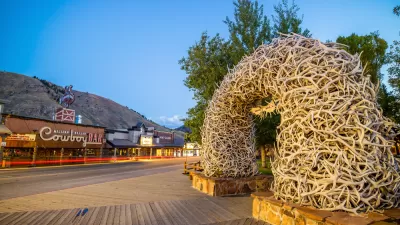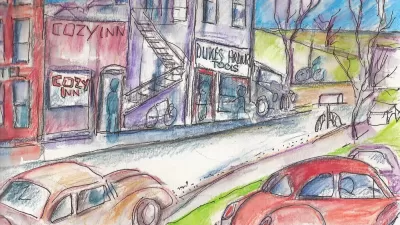Working for a small town doesn't just teach you how to plan a community; it teaches you how to be a part of it.

What is small town urban planning? If the phrase reads like an oxymoron, that’s because it is. A great deal of this discipline we call “urban planning” is not what it seems. That fact is magnified in the small town. “Urban” implies complexity. “Planning” implies control. These are the jokes that always make me smile.
Numbers vary but there are more 17,300 communities in the United States with populations under 50,000 (credit to Mary Means, contributor in the comments section). These, to me, are the small towns. Especially when you live in one. Indeed, it is a surprising discovery when you find yourself in a town that is 500 times larger than your old high school and yet operates under the same dynamics—the cliques, the gossip, the drama, and the archetypes. It’s the stuff of yearbook superlatives. Every small town has an identifiable, universally-accepted Class Clown, a Most Athletic, a Most Spirited, and a Most Likely to Succeed.
When you work for their local government, especially as a planner, the challenge is to fix their problems with solutions that you can defend on the street. This is one of the more beautiful aspects of the job. During my tenure, I was often stopped on the sidewalk and asked about form-based codes. People who had never heard of the concept would look directly into my eyes and ask, “Is this a good idea? I just want to hear it from you, Norm, because if you think it’s a good idea, then we’ll be behind you.”
The next week, this same born-and-raised, civic-minded citizen would say, “Norman, this idea for a sidewalk along the highway is terrible and it’s going to hurt my business.”
Such upfront honesty! Such naked concern! Such earnest desire! This is the essence of small town planning. It is an experience born from a mix of transparency, access, tradition, and civitas that is always present in small towns. And it is an experience that has made me more of a leader than I could have ever imagined.
This was not by my own choosing. Leadership is thrust upon you in the small town. If you ever want to make a difference in these places, leadership becomes your default condition. The work cannot be delegated or contracted out. If something should be done, it comes down to you to do it. Oftentimes, this makes you the unseen hero. On occasion, it makes you the well-known villain. In all instances, it makes you a better planner.
For those who seek to experience something real and satisfying in their careers, go to a small town and try to improve things. You’ll learn rather quickly what is and is not possible and how fragile our ideas really are. You’ll understand how every policy change has an impact on a neighbor’s quality of life. You’ll learn the negative correlation between leadership and popularity. You’ll discover that every decision you make is evident and readily judged by all the people who know you (and some who don’t). In other words, you’ll learn how our profession intimately affects the the people around us. There is a paucity of such knowledge.
I have made mistakes in small towns but it could have been worse. The Commission-Council process saved the most egregious mistakes from becoming reality. Such caution, such check-and-balance, is the stuff small towns are made of. These places are nurtured by a classic contradiction: they are eager to improve themselves, yet gripped by a reluctance to change. Such qualities are healthier than I originally thought.
Is there politics and infighting? Of course. After all, the big cities can’t have all the fun. But the loving nostalgia runs deeper than the bitter gossip. Everyone desires to see the place become what it once was. And unlike the big city, with their amorphous economies and global synergies, small towns are usually made of a singular people who have chosen to return or otherwise couldn’t leave. Most will live their whole lives here. So when you write a plan for their downtown, you’re writing a plan for the place they played as a child. A place where their parents worked. A place where the bedrock is formed by generations of memories.
And there is a myth about small towns that we should quickly dispel. For all the challenges, small towns are not the proving ground for planners. This isn’t some wind tunnel to test yourself against the minor forces, nor is this the place to develop your resume for a future in “the real city.” It doesn’t work that way. You will gain nothing from viewing the small town (or anything else) as a resume builder. What you learn here is much more important than that. You learn why people live together in these strange things we call “communities.” You learn how to observe them, how to help them, and how to see the neighborhood that lies just beneath the GIS imagery. As a planner for a small town, you don’t learn how to plan it. You learn how to be a part of it.
Maybe these are things one can learn in a large city, too. Maybe I’m just waxing nostalgic the way small town people do. Maybe I’m just feeling morose about a place, and a profession, that I’m about to leave. If so, let’s avoid turning this into some Mellencamp-flavored love letter and offer some balance.
Planning in a small town has been a joy. It has also been the most difficult experience of my career. It lead to physical threats and literally drove me to tears on occasion. It made me question the purpose of my profession. It made me give up. For a couple of days, anyway.
It obliterated my foundations and helped me realize that the designs and theories of your favorite urbanist du jour are only an abstraction of what the town and city really is: people. Planning for the theory, the aesthetic, and the system is easy. Planning for the people is hard. But it is the only way that keeps you honest, gives you principles, and makes you good. I will always hold the greatest respect and admiration for those who understand this. More often than not, they learned it here in these small towns.

Trump Administration Could Effectively End Housing Voucher Program
Federal officials are eyeing major cuts to the Section 8 program that helps millions of low-income households pay rent.

Planetizen Federal Action Tracker
A weekly monitor of how Trump’s orders and actions are impacting planners and planning in America.

Ken Jennings Launches Transit Web Series
The Jeopardy champ wants you to ride public transit.

California Invests Additional $5M in Electric School Buses
The state wants to electrify all of its school bus fleets by 2035.

Austin Launches $2M Homelessness Prevention Fund
A new grant program from the city’s Homeless Strategy Office will fund rental assistance and supportive services.

Alabama School Forestry Initiative Brings Trees to Schoolyards
Trees can improve physical and mental health for students and commnity members.
Urban Design for Planners 1: Software Tools
This six-course series explores essential urban design concepts using open source software and equips planners with the tools they need to participate fully in the urban design process.
Planning for Universal Design
Learn the tools for implementing Universal Design in planning regulations.
Ada County Highway District
Clanton & Associates, Inc.
Jessamine County Fiscal Court
Institute for Housing and Urban Development Studies (IHS)
City of Grandview
Harvard GSD Executive Education
Toledo-Lucas County Plan Commissions
Salt Lake City
NYU Wagner Graduate School of Public Service





























